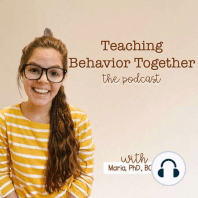9 min listen

Using ABA Principles to Teach Academics with Cassie from Adventures in Behavior
Using ABA Principles to Teach Academics with Cassie from Adventures in Behavior
ratings:
Length:
21 minutes
Released:
Feb 9, 2021
Format:
Podcast episode
Description
Using the principles of aba to teach academics is a long standing practice. After all, academics are behaviors, right? In this episode, I chat with Cassie from @adventures.in.behavior about how she uses ABA to teach academics in her classroom. In this episode she talks about different strategies she uses to teach a variety of academic skills. These strategies provide a framework for teaching specific skills but can be applied to really any academic skill. Some of the strategies she uses include discrete trial training, prompting programs, and direct instruction programs. Discrete trial training is a specific systematic method for teaching discrete skills. Discrete skills are skills like letter identification, math facts, identifying shapes, numbers, etc. You would use discrete trial training to teach these explicit skills over time and build on the mastery of different concepts. Often we use discrete trial training in a one-on-one format, but I have seen it done in a small group format too. In order for this strategy to be successful, you have to be pretty fluent in the methods to keep up the pace of a session. We want to keep up the pace so that students stay engaged and have fun in the process. Prompting programs, like errorless prompting are a great way to teach new skills that allow our students to build on success. If you are using errorless prompting you are providing a prompt towards an academic skill such as "match the shapes" and then immediately prompting to the correct answer. This is great because it allows our students to build on success and eventually we fade out that prompt so our students maintain their success and independence. Lastly, we talk about direct instruction programs. Direct instruction is a method of instruction delivery rooted in the principles of behavior change. The programs are scripted and provide a systematic progression for teaching a variety of skills. These programs are great for teaching a variety of skills and take the guess work out of teaching those skills. Don't worry though, you can add your own teaching style to direct instruction programs and include fun and engaging strategies inside the programming to keep your students interested. Join the Teaching Behavior Together CommunityGrab a FREE Intervention Implementation Guide to effectively and efficiently implement interventions in your classroom (Click Here)Visit my website for more strategies and interventions you can use daily in your classroom. (Click Here)Follow me on Instagram for daily behavior and social emotional learning tips (Click Here)Follow me over on Pinterest for all things behavior and social emotional learning (Click Here)
Released:
Feb 9, 2021
Format:
Podcast episode
Titles in the series (65)
Let's Get to Know Each Other by The Teaching Behavior Together Podcast